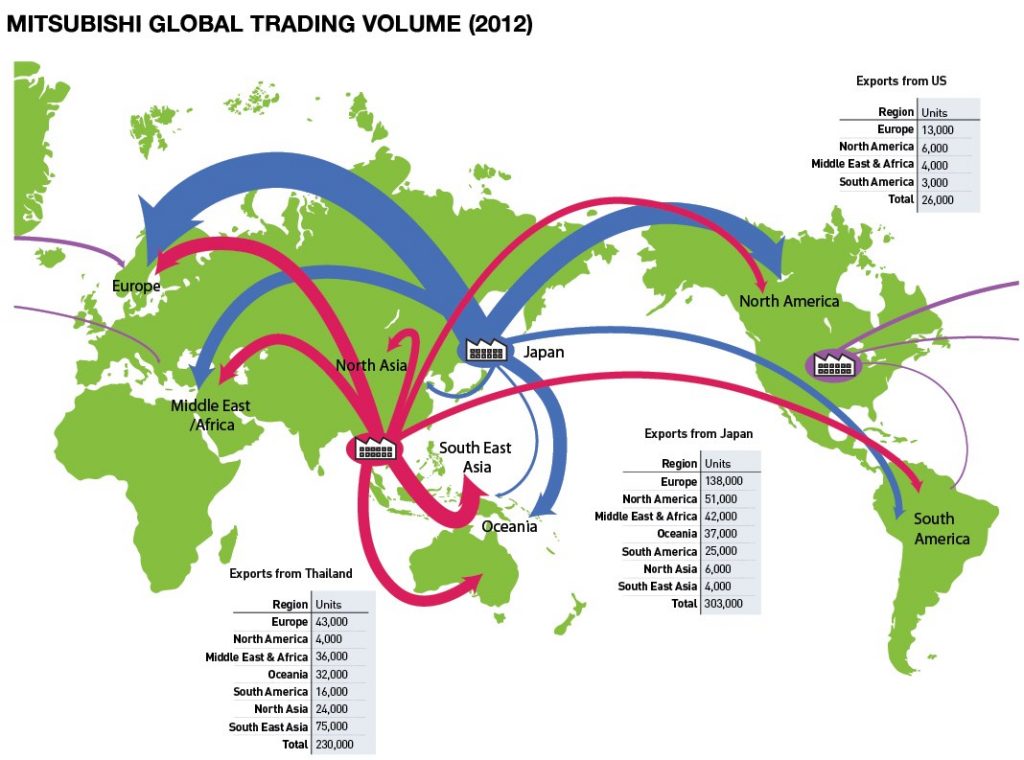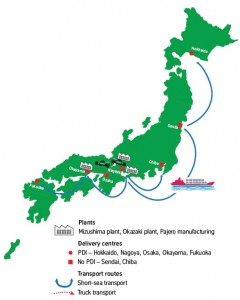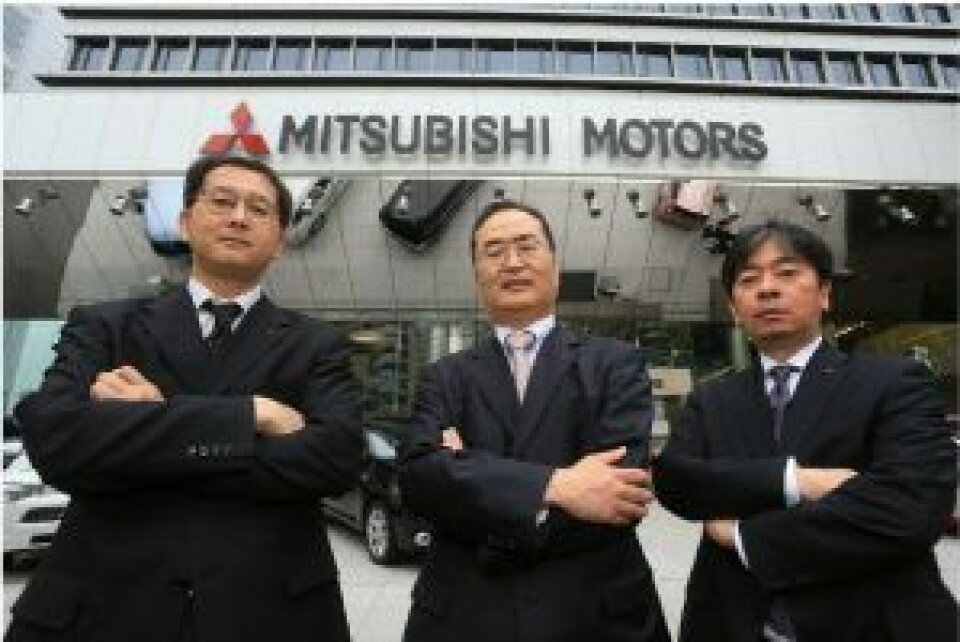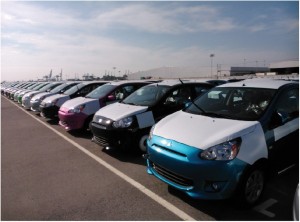Welcome to the next stage for Mitsubishi
 Kyoji Miwa reveals how Mitsubishi is redefining its production and distribution footprint to increase sales in the ASEAN region and further afield
Kyoji Miwa reveals how Mitsubishi is redefining its production and distribution footprint to increase sales in the ASEAN region and further afield
Japanese exporters have not had an easy time of it in recent years. Starting with the financial crisis that took down many of their established markets in 2008-2009 (and left OEMs with literally boatloads of excess vehicle inventory) manufacturers in the country have been hit with a succession of economic, political and natural disasters that have mainly been external to their core business.
The Japanese earthquake and tsunami of 2011 disrupted supply chains and vehicle exports globally; just as volume started to recover, a political row with China led to a backlash that saw Japanese cars set alight and a major drop in sales for such brands in the world’s largest market. For several years, meanwhile, the yen’s record-high strength put a serious dent in export profits. A sluggish domestic market did little to offset the troubles abroad.
These challenges hurt Japanese carmakers in different ways, depending on their size and the geography of their sales and production networks. A relatively small carmaker like Mitsubishi Motors Corporation, for example, was very exposed to these disruptions, given its strong base in Japan as well as its dependency on the struggling European market. In the calendar year 2008, for example, the carmaker produced almost twice as many vehicles in Japan (nearly 842,000) as it did in overseas markets (459,000). Although small by Toyota’s standards, Mitsubishi was still a major exporter from Japan, shipping more than 600,000 vehicles that year, according to the company’s public data.

Mitsubishi has since been undergoing tectonic shifts in its production footprint as well as in its export flows. In the calendar year 2012, the carmaker’s overseas production outpaced that of its Japanese plants for the first time, with around 591,200 vehicles assembled abroad compared to 517,000 at home (see chart). Even with conditions in Japan changing in 2013, including a dramatic fall in the value of the yen, that globalising trend has continued: in the first ten months of the year, overseas production had risen 12.6% versus the same period in 2012 to 539,800 vehicles, while Japanese output was up 7% to 480,300 units. That difference is perhaps even more notable since Mitsubishi ended production at a car plant in the Netherlands, and also since it no longer includes China output in its offical overseas data (operations in which Mitsubishi has only minority stakes or licence deals).
The change in exports has in some ways been even more dramatic. Mitsubishi has not entirely shifted to a regional production strategy, with global vehicle shipments still playing a major role for the company. However, it ships about half as many vehicles from Japan as did five years ago, while the carmaker’s production and exports from Southeast Asia, notably Thailand, have risen strongly. In 2012, for example, while finished vehicle exports from Japan were 303,000 units, vehicle exports from Thailand reached 230,000 units, with high volume sent both regionally to countries in the Association of Southeast Asian Nations (ASEAN), as well as to Europe, the Middle East and China (see chart above). Kyoji Miwa, general manager of Mitsubishi’s export operations department, points out that its vehicle exports from Thailand are increasing as a percentage of the company’s total exports.
Mitsubishi also exported 26,000 units from its US plant in Normal, Illinois in 2012 to destinations that include Russia; US exports have risen again in 2013 and are expected to grow further. In future, Miwa and his team suggest that the carmaker could consider exports from other manufacturing locations, such as from China or Russia, for example.
A big player on the open seas
The development of these export routes demonstrates how for Mitsubishi, perhaps more than many other carmakers, ocean shipping is tied inextricably to its sales and production strategy. With more than 85% of exports moving by sea, the relatively small OEM is actually a big player for ro-ro transport. Even in its domestic distribution market in Japan, for example, the carmaker uses seven ports and more ro-ro shipping than truck transport.
The new production shifts may have changed the volume on trunk lines out of Japan, but they are re-emphasising the importance of an effective shipping and port strategy. Moving production out of the Netherlands to Thailand, for example, is part of what led the carmaker to develop a comprehensive hub-and-spoke shipping system for Europe, including using two ports in the north and two in the south of the continent. Likewise, Southeast Asian nations are, by their very geography, suited to shipping, which Miwa expects will play an even larger role for the region in future.
With complex export flows and a continued reliance on global shipping, Mitsubishi is also renewing focus on its order-to-delivery processes and IT systems. As with other Japanese manufacturers, the total cycle is longer for overseas production than it is for Japanese production because of inbound parts requirements, which makes communication and visibility of order progress even more important. As part of the company’s recently unveiled growth strategy, ‘New Stage 2016’, which aims to increase revenue and profits for the next three fiscal years, Miwa reveals that the company will invest in new systems.
Setting the stage for ASEAN growth
Thailand and the wider ASEAN region make up an important part of Mitsubishi’s sales, production and export network, with its relevance set to increase further. One of the pillars of New Stage 2016 is to strengthen the production and sales base in ASEAN. The company is targeting an increase in sales across the region’s five major markets (Thailand, Indonesia, the Philippines, Malaysia and Vietnam) from 270,000 vehicles in the 2013 financial year to 390,000 by 2016.
“Of New Stage 2016’s five basic policies, I believe that reinforcing our production base in ASEAN countries and establishing an SUV brand with a strong foothold in emerging markets have greatly influenced our logistics perspectives,” says Miwa.
Mitsubishi has fully owned plants in Cainta, the Philippines (near Manila) and Khlong Luang, Thailand (near Bangkok), while it also builds vehicles with partners in Malaysia, Vietnam and Indonesia. Its plant in Thailand currently exports to 140 countries worldwide. According to Miwa, Mitsubishi is strengthening operations in the region by building a flexible production and sales framework. It is also introducing new models, including the 2014 Mitsubishi Triton pickup, which is being exported from Thailand.
“In the near future, we will likely expand our finished vehicles logistics network among these countries as well as [develop] worldwide logistics networks from them,” says Miwa.
With the rising complexity of flows, Miwa emphasises the need to make the best use of the limited availability of vessels, skills, and materials. With the fast-growing export volume out of Thailand, for example, Mitsubishi has adapted a ‘pendulum’-style service from ro-ro carriers that connects Thailand and Japan to Europe on one side, and Japan with the Americas on the other side.
“For our exports from Thailand to Europe and Japan, we call Thailand en-route to Europe, and on the back way to Japan we also call Thailand in order to make the best use of the rather vacant space from Europe to Japan,” explains Miwa. “Before the pendulum services, we had open space.”
Re-engineering the European port network
While ASEAN’s role will increase, Mitsubishi’s largest export market is still Europe (including Russia), with large flows to the continent from Japan and Thailand, and growing volume from the US. The end of local production in the Netherlands has also bolstered exports to the region.
As important as Mitsubishi’s export network is to its global growth strategy, its Japanese vehicle distribution network remains significant. Here, again, geography makes sea transport the dominant mode in distribution (Japan is made up of four major islands). Mitsubishi uses truck transport for fewer routes than it uses short sea – even for movements within the island of Honshu, where all three of the carmaker’s plants are located.
Mitsubishi sends vehicles to seven ports for domestic sea transports from its plants: Hokkaido, Tohoku, Kanto, Nagoya, Shikoku, North Kyusyu and South Kyusyu. The company has seven ‘relay places’ (temporary stock holding areas, see map below) for sea and land transport. PDI operations are carried out in five port areas and delivered to each relay place for availability to the dealers and customers. Miwa says that within the past year, Mitsubishi has re-examined each yard for all of its dealers, centralising and reducing the number of facilities.
Within the past year, Mitsubishi has reorganised its port network in Europe to create a hub-and-spoke system, which has led to reduced handling and costs. “We used to ask each shipping company to call each port in each country. Now, we centralise distribution to the major ports and deliver the vehicles from there,” says Miwa.
With this hub port scheme, the shipping company does not need to call each port, which reduces the total ocean lead times as well as the cost for each call. The carmaker now has hub ports at Zeebrugge, Belgium; Bremerhaven, Germany; Gioia Tauro, Italy; and Piraeus, Greece – two each to serve the northern and southern halves of the region.
Mitsubishi generally has a direct-to-dealer delivery strategy. For example, it uses terminal operator ICO to carry out pre-delivery inspection and storage at Zeebrugge for vehicles destined for Belgium, the Netherlands and France. Groupe CAT is then responsible for distribution to these markets.
However, from the hub ports Mitsubishi also uses 15 spoke ports for short sea, some of which serve multiple countries, including the ports of Derince, Turkey and Koper, Slovenia.
Global hub ports
Outside Europe, Mitsubishi uses a hub port network for both its Japanese and non-Japanese production. For Japanese exports, Mitsubishi uses the ports of Nagoya and Mizushima (which are each close to Mitsubishi plants), as well as Singapore, according to Hideyuki Kanno, export operations department manager in charge of finished vehicle exports from Japan. Mitsubishi routes some vehicles directly to destinations from either port, while consolidating vehicles for onward flows at others, such as in Singapore for shipment to Europe and the Middle East.
For vehicles built outside of Japan, Mitsubishi’s hub ports include Baltimore on the US east coast; Nagoya; Laem Chabang, Thailand, and Singapore. According to Koichi Terashima, manager of the export operations department, responsible for vehicle exports from plants outside of Japan, these ports also help to centralise flows for onward distribution. Vehicles built in Thailand will serve some markets directly from Laem Chabang, such as other countries in Southeast Asia, while some destinations, such as North Asia and the Americas, are transhipped via Nagoya.
Further changes to the global port network could be made. For example, Mitsubishi is studying centralising port and yard operations together with onward distribution in regions where the discharge ports are close to final markets, as it has done in Zeebrugge, for example. Miwa says that the company needs to look particularly at the ASEAN area for the possibility of establishing a hub port network. Already, it has been using Singapore as something of a hub, although Miwa admits there is not much space there. Mitsubishi will look at the network more closely as volumes increase.
“The more we strengthen our regional strategy as part of New Stage 2016, there will be more opportunities for centralisation of ports, yards and distribution centres,” says Miwa. “On the other hand, regions such as South America or the Middle East would be difficult to establish a hub and spoke network in due to our lack of a capital relationship in these ports.”
Since Mitsubishi’s exports from ASEAN countries are growing, as is cross-trade within the region, the number of vessels, frequency, capacity and service lines is also increasing. The ports themselves will likely invest further to attract carmakers, which Miwa says Mitsubishi is monitoring closely.
Allocating vehicle flows
At the core of Mitsubishi’s worldwide logistics programme are several systems that keep its network flowing smoothly. The export department managers see IT tools as a way to improve transparency to the customer as well as to reduce costs. Miwa believes that in the future, every stakeholder will be able to access Mitsubishi’s ordering and logistics system to obtain the status of their vehicle orders.

Mitsubishi uses an in-house system for vehicle order planning and prioritises its order data by customer requirements. Firm orders have either been committed to customers (and are thus classed as ‘urgent’) or are stock for distributors or dealers (‘normal’), while there is also a category for fleet or retail orders. Along with firm orders, the system provides forecasts to the manufacturing side.
Mitsubishi’s vehicle allocation system entails two stages of data processing. The first is to submit production requirements to the factory, while the second stage is the final fix of the shipment.
“In the first stage, Mitsubishi has the vessel’s master file for each logistics route. Therefore, taking our order planning considerations into account, we have set up the order production sequence when we submit the production requirements to the factory,” explains Miwa. “Of course, parallel production is ideal for the factory, but sometimes we encounter situations in which the vehicles could not be produced as planned. In such cases, we would reprioritise and mitigate the difference.”
The second stage of the allocation process begins with the vehicles’ availability for shipment, which is two or three days before they actually ship. Once the vehicles are ready for dispatch, Mitsubishi has two types of allocation systems for assigning them to a vessel. Miwa says that if there are restrictions regarding the shipments, such as letter-of-credit instructions or advanced shipment in the trade terms and conditions with the distributors, Mitsubishi will specify the vehicles to ship. If there are no restrictions, it ships according to the vehicles’ availability.
Once Mitsubishi’s vehicles ship from port, it relies on tracking information systems through collaboration with major car carriers including NYK, K Line and others. These companies provide information regarding the vessel’s status with respect to the estimated time of arrival or transhipment details. Thanks to the information provided by shipping companies, Mitsubishi’s ETA predictability has improved, says Miwa.

However, he points out that growth out of the ASEAN region depends on a large amount of transhipment and it is here that Mitsubishi needs better data and communication from shipping lines.
“When we consider the escalation of trade between the ASEAN region and other destinations, we need transhipment information, such as the second or third port or beyond; and the vessel name and movement status, such as the ETD/ATD [estimated time of delivery/actual time of delivery] at the transhipment ports and the final points,” explains Miwa. As production increases, he adds, Mitsubishi will need more information about vessel reloading times and the number of reloadings.
Controlling order-to-delivery cycles
Mitsubishi tries to minimise the order-to-delivery cycle as much as possible, says Miwa. However, inbound material lead times have a big impact on total delivery time. The time between order placement and final delivery for a Japan-produced vehicle to a global destination is around 2-3 months. For production outside of Japan, which still relies on some imported parts from Japan, an extra month is typically needed, he says.
As has been the case with other Japanese OEMs, including Toyota in Europe and the US, Mitsubishi has been working on shortening this cycle for global production, but that takes time, too. “As we focus on strengthening production in the ASEAN countries, minimising the order-to-delivery cycle time is a difficult challenge to overcome,” admits Miwa.
"As we focus on strengthening production in the ASEAN countries, minimising the order-to-delivery cycle time is a difficult challenge to overcome" - Kyoji Miwa, Mitsubishi
Mitsubishi must also consider reducing part obsolescence in production cycles, especially when it switches from previous models to new models, all of which could be addressed by stronger systems. “We must consider sorting out these parameters in our New Stage 2016,” proposes Miwa. “We used to have a difficult time during the ‘Jump 2013’ plan and we did not have sufficient resources to invest in systems development. Now, we have a plan to introduce new universal systems and software to improve our efficiency during the course of New Stage 2016.”
However, Miwa points out that new systems are not a cure-all for the order-to-delivery cycle; some manual adjustments might be required in terms of practical operations. Miwa says that Mitsubishi needs to analyse the results from such systems carefully to meet customer requirements and the goals of its mid-term business plan.
A global partnership approach
While Mitsubishi prioritises ASEAN as its most important emerging region, it has also expanded in Brazil, Russia and China. In China, Mitsubishi is part of joint ventures South East (Fujian) Motor and GAC Changfeng Motor. In Russia, it is part of the joint venture Peugeot Citroën Mitsubishi Alliance, located in Kaluga, which produces the Mitsubishi Outlander. “We have the possibility of exporting from these countries, and thus must consider logistics routes,” says Miwa.
Mitsubishi has also recently partnered with Renault Samsung in South Korea to build a D-segment sedan that will be exported to North America with the Mitsubishi badge.
Miwa foresees growth for Brazil, particularly in the run-up to the FIFA World Cup and the Olympics. It has a factory in Catalao, Brazil, in the inland state of Goias, through a local partnership called MMC Automotores do Brasil, which produces the ASX compact SUV. Mitsubishi’s central logistics team makes decisions together with the local company. “Corporate decisions through close communication with these partners come first, then logistics decisions will follow,” says Miwa.
Mitsubishi is off to a good start in its new objectives and restructured networks. For the fiscal year 2013, the company is predicting sales revenue of more than ¥2 trillion ($19.5 billion), which would be its highest since 2007. The first ten months of this calendar year have seen a healthy rise in Japanese and overseas production. The drop in value for the yen and the recovery in production following natural disasters in Japan and Thailand will help the company’s output and profits in the short term. In the long term, increasing production, sales and exports in and from ASEAN will make the carmaker a significant player in the region. Likewise, Mitsubishi’s export and distribution approach, including its use of hub ports, means ocean shipping should remain a strong pillar of its expansion strategy.
Additional reporting by Christopher Ludwig





